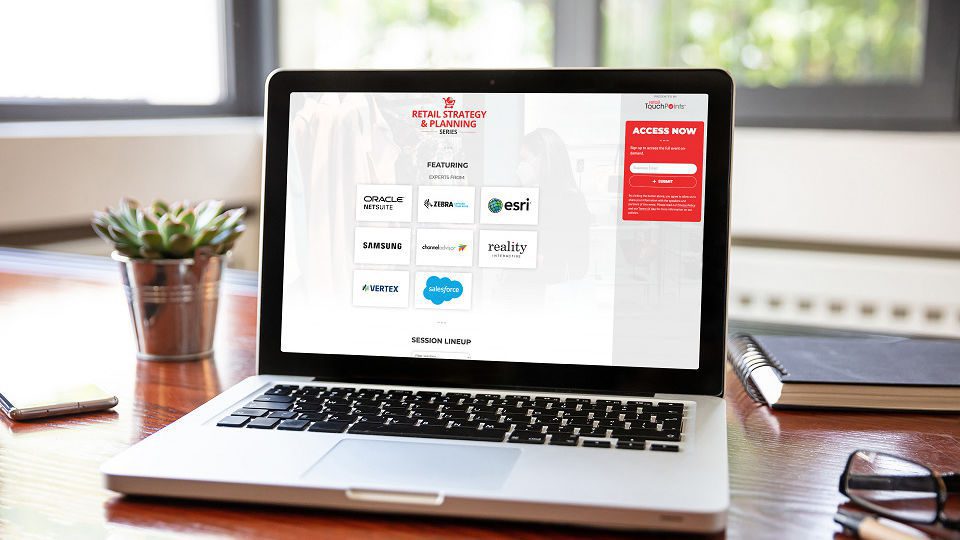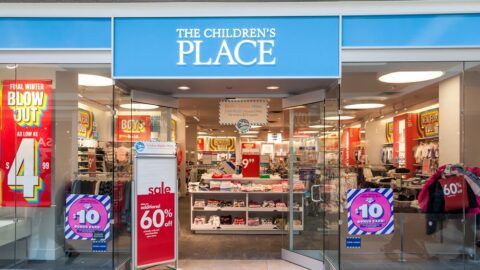Retailers seeking guidance as they look ahead to an uncertain Q4 will find plenty of solid, practical advice in the 2020 Retail Strategy and Planning series of webinars, now available on-demand.
Session topics ranged from ramping up touch-free in-store technologies to strengthening supply chains and getting the most out of marketplaces. Speakers included industry experts from RSR Research, Coresight Research and Creative Realities as well as retail executives from companies including Office Depot and Regina Andrew Design.
Following are brief recaps of the #RSP20 sessions:
Online Retailers Must Look to Automation to Support Global Expansion
The Wayfair decision, which allows U.S. states to charge tax on purchases made from out-of-state sellers —even if the seller does not have a physical presence in the taxing state — has had widespread implications for ecommerce.
Advertisement
These changes to state sales tax collection requirements have a global impact. “Tax complexities can make overseas online retailers reluctant to expand into the U.S.,” said Pete Olanday, Retail Practice Leader for tax automation vendor Vertex in the session titled: Global Expansion Creates a Brave New World of Challenges for Retailers.
As a result, many retailers must move beyond manual processes to calculate their sales tax obligations. A centralized tax automation solution eliminates the need for frequent updates within individual retail applications supporting both ecommerce and brick-and-mortar sales.
The post-COVID tax environment remains unknown: rates could go up or come down for a limited time as a way to help restart the economy. “States could extend sales tax holidays to encourage buying, or increase rates to recoup revenue,” said Olanday.
Leverage Digital Tech for Touchless Store Experiences
Retailers are faced with the task of creating immersive shopper journeys within their brick-and-mortar stores, while at the same time reassuring skittish consumers that the experience is safe for them. Adding to this challenge is the fact that many retailers have been forced to lay off staff in stores due to the pandemic — and some might never get back to their pre-COVID personnel levels.
All these factors have retailers seeking ways to maximize their existing solution sets as well as making smart technology investments for the future.
“We’re seeing technologies that were put in place for one thing now being used for something that wasn’t planned,” said Jeremy Brazeal, Creative Director of Reality Interactive, during the webinar session titled Designing the Future of Brick-and-Mortar: 5 Ways to Build Safe Yet Immersive Experiences.
To make it easier for customers who no longer wanted to interact with another person for health or safety reasons, Brazeal suggested that retailers tap their ecommerce systems “to self-navigate that product journey” in stores.
“Brands are trying to do the same amount of work, or more work, with less,” said Jessica Amenta, Account Director of Reality Interactive. One solution is to bring content that retailers already are updating digitally, such as pricing or user-generated reviews, into the store to keep the information fresh.
Why Brands Shouldn’t Shun Marketplaces
Brands often overlook marketplaces due to concerns over losing control of their messaging, pricing and customer interactions, but this can be a costly mistake, said Cathy Hinek, Manager, Marketplaces Client Services, ChannelAdvisor during a session titled: Inside the Digital Mall: How Brands Can Bolster Their Marketing Strategy.
“Brands need to take a serious look at some of our deeply held beliefs about marketplaces,” said Hinek. She highlighted some of the myths about marketplaces: “Just because your brand doesn’t own the marketplace doesn’t mean shoppers aren’t brand loyal. You can encourage initial purchases and repeat business by fulfilling quickly, responding thoughtfully and promptly to inquiries and reviews and by maintaining a competitive pricing structure.”
Marketplaces offer a number of options for brands to tell their stories, Hinek noted: Amazon and eBay offer opportunities for branded storefronts and content.
Being on a marketplace doesn’t mean devaluing your brand. “Your brand is likely already on marketplaces, just not by you and how you want it presented,” said Hinek.
Shoring Up Overstretched Supply Chains
Prior to the pandemic, many companies were facing supply chain challenges due to tariffs, natural disasters and other issues. COVID only intensified the difficulties of doing business globally.
“This year has highlighted the need for visibility with offshore suppliers and the fragility of the supply chain,” said Craig Harris, Segment Leader and Master Industry Principal, Oracle NetSuite, in the session titled: Responding to Uncertainty: Should You Localize Your Supply Chain?
Companies such as Regina Andrew Design, a seller of lighting and home décor, are weighing the options of reshoring at least some manufacturing. “When doing the cost-benefit analysis, it is easier to communicate and control the process and check for quality and consistency when manufacturing is based in the U.S,” said Jim Bonomo, COO at Regina Andrew Design. He noted that the company already had brought some custom work back to the U.S.
How to Optimize In-Store Tech for All Stages of the Shopper Journey
Two trend shifts are driving retailers to assess their in-store technologies: the dominance of Millennial and Gen Z consumers, and the increased desire of consumers of all ages for contactless store environments.
“You can’t fool this audience,” of younger consumers, said Beth Warren, SVP Marketing and Retail Practice at Creative Realities, speaking during the webinar titled: Rethinking the Role of In-Store Tech: How to Build a Flexible Ecosystem That Builds Shopper Trust and Maximizes ROI. She added that one way retailers can respond to younger generations’ preferences is by using technology and content to bring authenticity and transparency into the shopping experience.
“Your brand has to make [technology] decisions based on your brand’s image and [the relationship] you want to have with your clients,” said Parrish Chapman, Director of Sales for the B2B Retail U.S. Market at Samsung Electronics America Display Division. “We can replace paper and have limited contact with a whole host of our solutions.”
Prime Day and the Last Mile Will Shape Holiday 2020
The shift to ecommerce accelerated by COVID-19 will ramp up pressure on the supply chain for the upcoming holiday season. “We expect an elongated season that starts earlier and potentially pushes into January,” said Deborah Weinswig, CEO & Founder, Coresight Research, in the session titled: How COVID-19 Will Shape the Holiday Season: 5 Predictions on the Future of Retail.
Increased digital competition will heighten the need for retailers to satisfy consumers. “Retailers should empower customer service agents,” said Caila Schwartz, Insights & Strategy Manager, Retail and Consumer Goods at Salesforce.
Schwartz shared five holiday predictions based on Salesforce Consumer Research conducted in May 2020:
- Ecommerce will account for 30% of global retail sales;
- Amazon Prime Day will push demand earlier;
- Last-mile capacity issues could delay 700 million packages this upcoming season;
- Websites offering click-and-collect options will grow their holiday digital revenues an average of 90% year over year; and
- The media mix will drastically shift, with 10% of mobile orders coming from social referrals.
Checklist to Ensure a Profitable Holiday
If COVID consumer behavior continues, buy online, ship from store as well as buy online, pick up in-store (BOPIS) will increase for holiday 2020.
“These capabilities are critical to meeting consumer expectations this holiday,” said Nikki Baird, VP of Retail Innovation for Aptos, during the webinar titled: Scaling Omnichannel Success: 3 Keys To A Successful Q4 and 2021.
Steve Ross, OmniSolutions Principal, Aptos, outlined these steps to ensure holiday success:
- Step 1. Perform a “health check.” “You don’t want to have a conversation with your CFO in January about holiday supply, shipping and labor costs,” said Ross.
- Step 2: Use empty retail space for distribution.
- Step 3: Adjust order routing. Look at your peak times and work with fulfillment centers to determine what should go to the stores and what should go to the fulfillment centers.
- Step 4: Prominently message BOPIS on your site.
Pandemic Has Accelerated Need for Both Short- and Long-Term Innovation
COVID-19 has squeezed changes that were expected to take place over the next three to five years into the past six months, according to Jonas Stillman, Director, Store Operations at Office Depot. Stillman shared his front-line experiences responding to the pandemic along with Mark Delaney and Tim Kane, retail industry consultants for Zebra Technologies, during the webinar titled: Riding the Three Waves Of Retail Disruption
In part because these changes have occurred so quickly, requiring fast responses from retailers and their ecosystem partners, proper recovery from COVID-19 will require a staged approach to operations upgrades:
- First, maintain stability by optimizing labor hours, meeting customer demands and emphasizing safety;
- Second, adapt to a “new normal” that includes the embrace of BOPIS programs, contactless options and digital/physical technology upgrades; and
- Third, undergo long-term transformation through methods such as sourcing diversity and last mile delivery optimization.
Location Intelligence Proving its Worth During COVID Recovery
Location intelligence has become an even more important tool for retailers as they respond to and recover from the pandemic, according to results from a recent RSR Research study discussed during the session titled: From Recovery To Innovation: How the World’s Best Retailers Are Using Location Intelligence to Transform and Drive Business.
“The research revealed that location intelligence is becoming table stakes, and that wasn’t the case even three years ago,” said Gary Sankary, Industry Marketing Strategy, Retail for Esri, a provider of location intelligence software that partnered with RSR Research on the study.
COVID-19 was an accelerant to changes retailers already were starting to make, such as adjusting business plans at hyperlocal levels. “Supply and demand both become unpredictable, highlighting the need for real-time visibility on a hyperlocal level.,” said Brian Kilcourse, Managing Partner, Retail Systems Research.
Some key points from the research:
- 89% of winners said it was especially important to assess and stabilize operations at a hyperlocal level, while it was a priority for only 65% of others.
- 80% of winners said their ability to supply and assess location risk and disruption was a top capability, while just 50% of others ranked it as a priority.
- 80% of winners assigned a higher value to combining geographic and demographic data for better business decisions, compared to 53% of others citing it as a priority.
The ability to localize COVID response will shape how retailers manage other types of disasters going forward. “Retailers must be able to monitor the arc of disruption at the local level and in real time,” said Paula Rosenblum, Managing Partner, Retail Systems Research.









